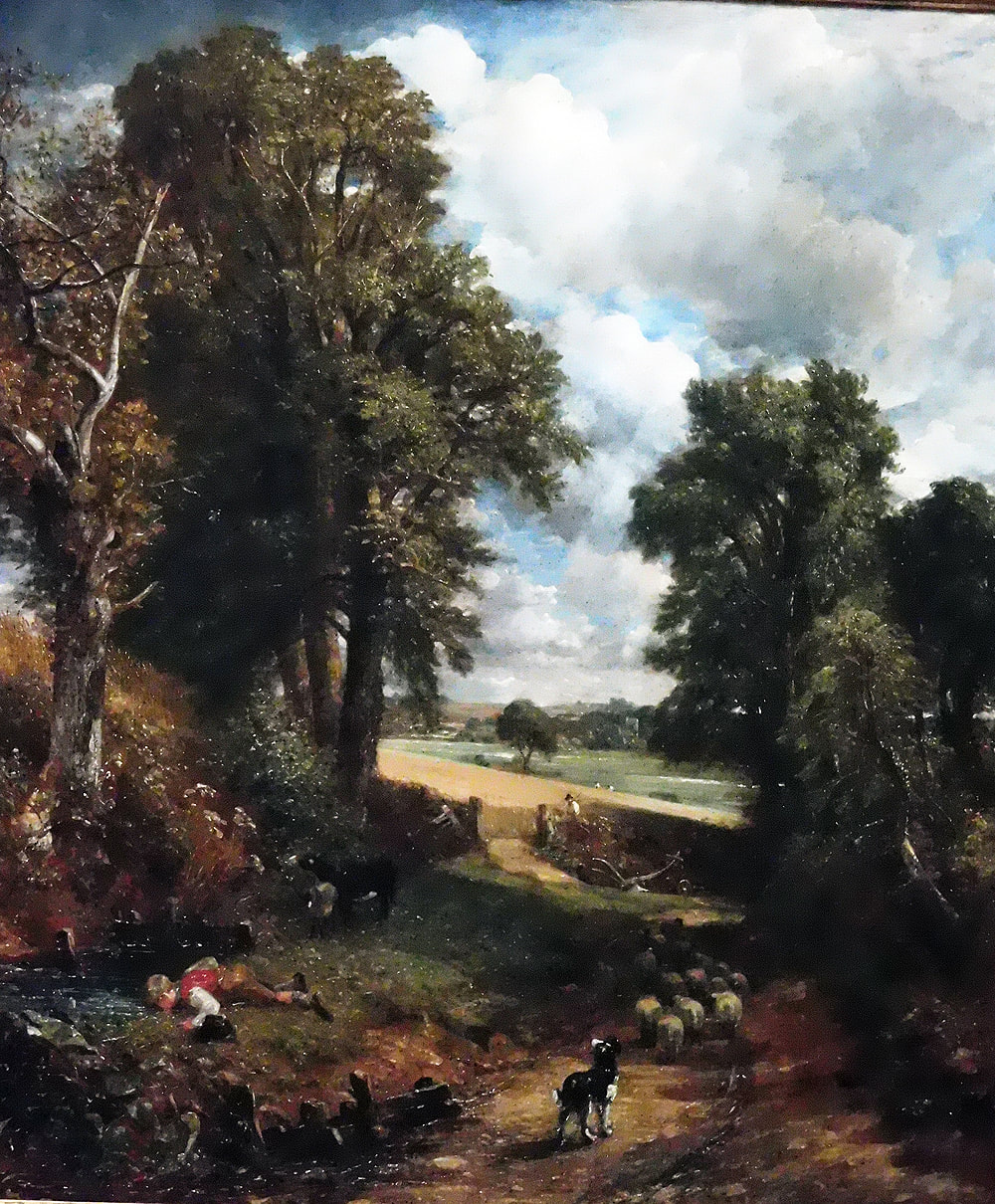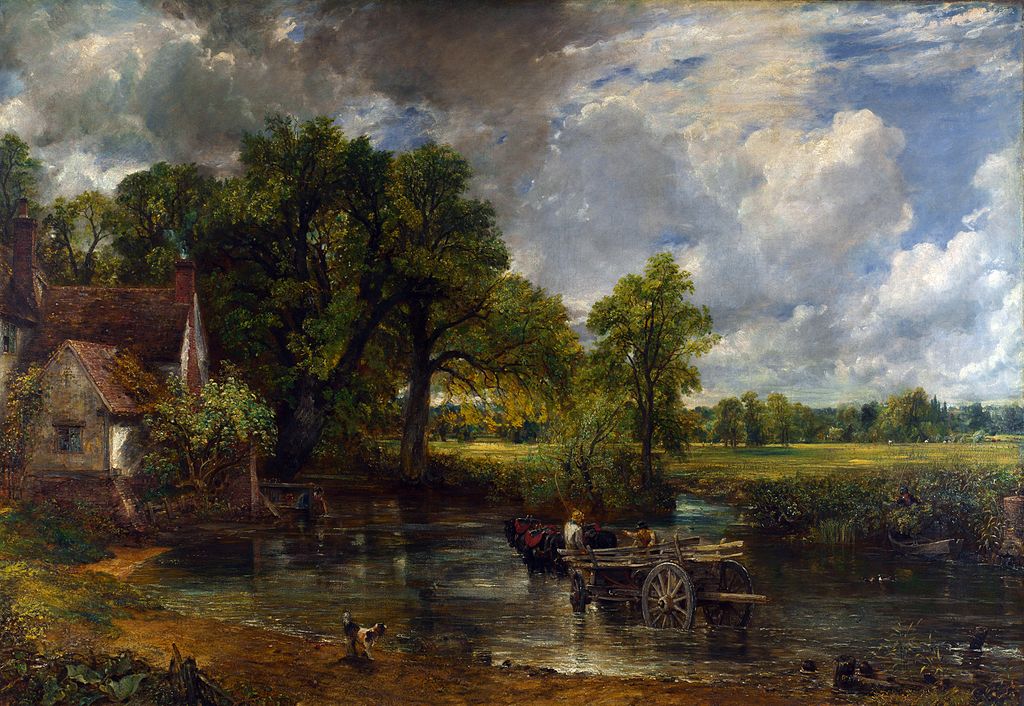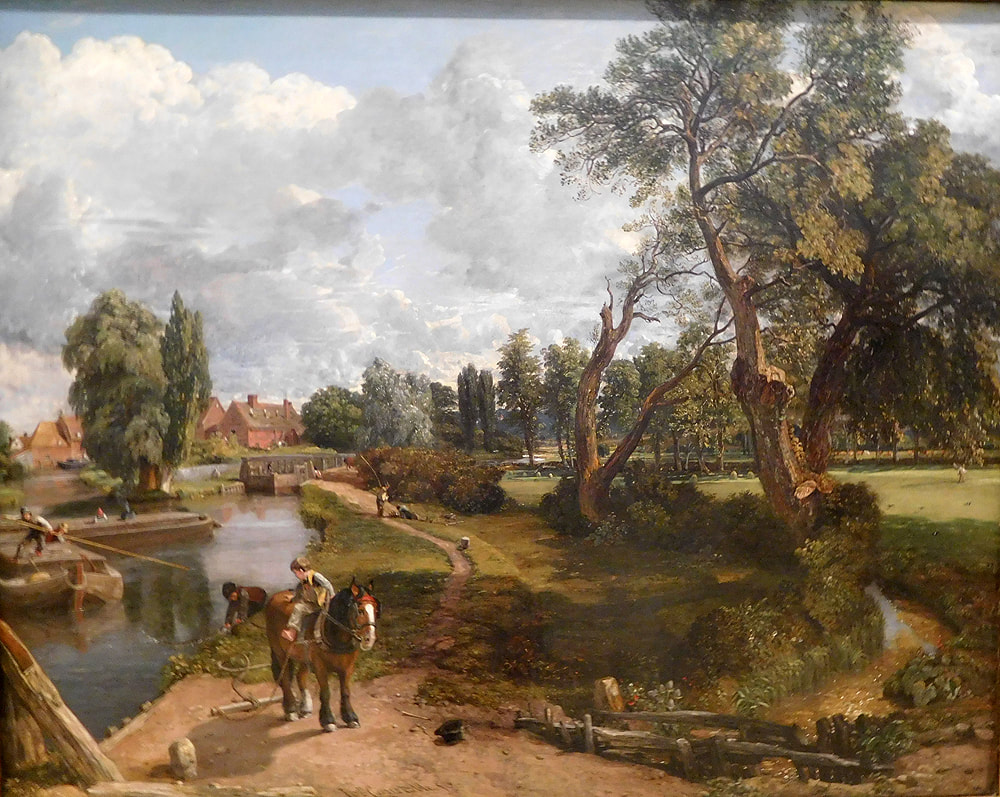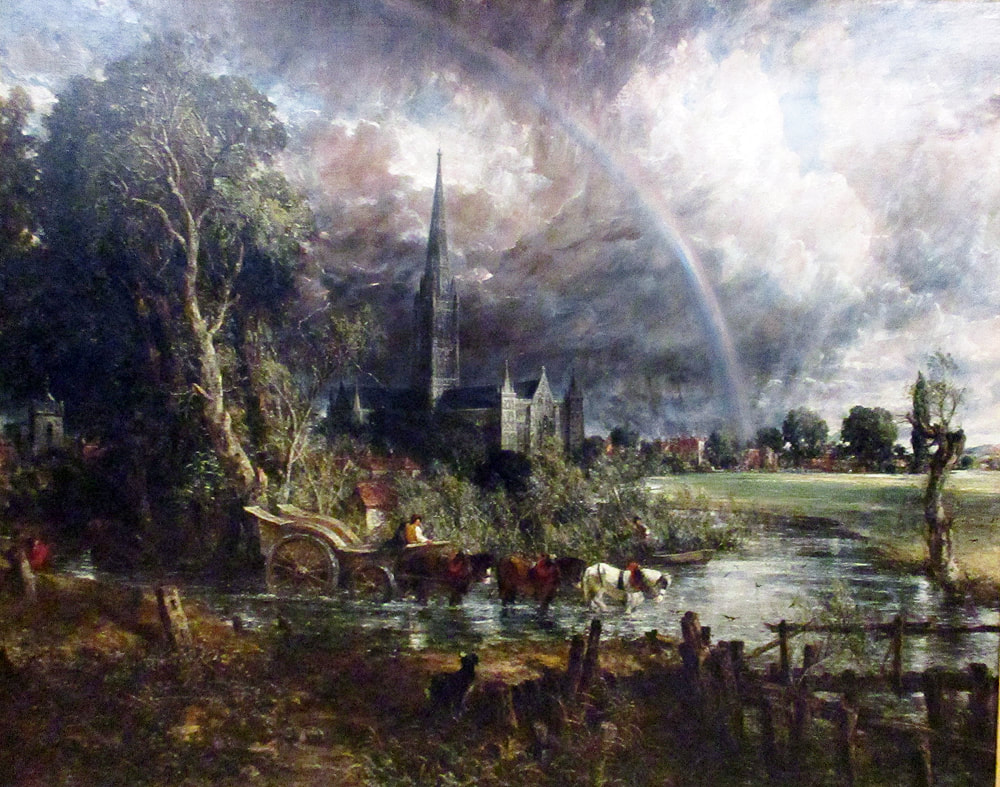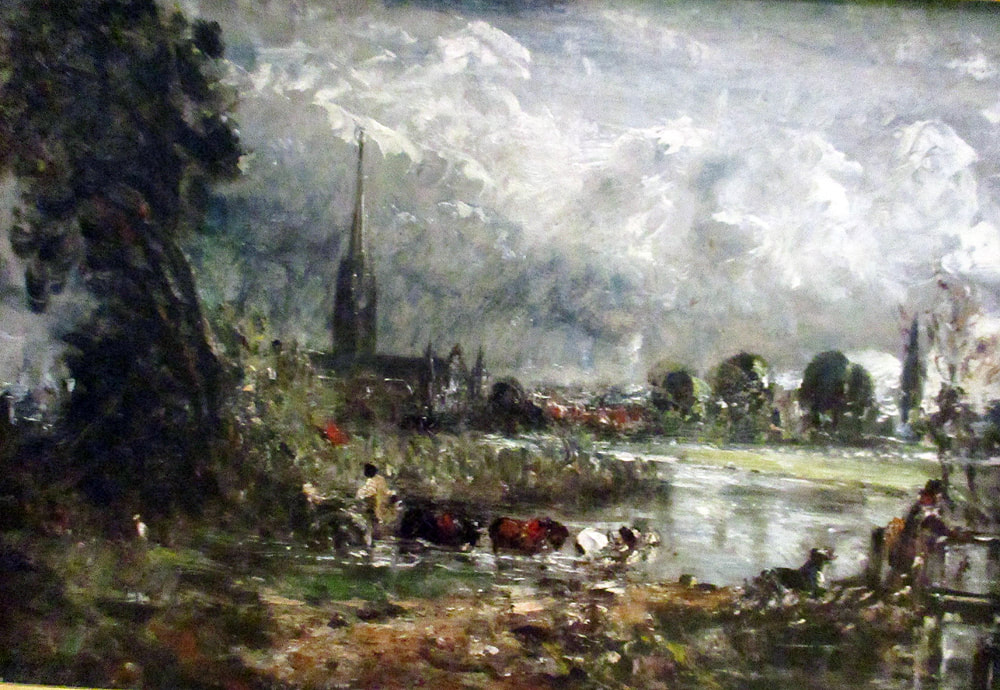AN APPRECIATION: John Constable John Constable was a revolutionary British landscape painter at the beginning of the 19th century. His works set the stage for the modern approach to landscape painting and even today remain at the forefront of this gendre.
Career Constable was born in 1776 in East Bergholt, which is in Suffolk, England. His father was a prosperous mill owner, who would ship grain to London on barges traveling the River Stour. John had little interest in his father's business but the mills, the river, the fields and barges became such a part of him that they became the subjects of most of his best known works. Growing up, John displayed an early interest in art. His parents tolerated this interest as an acceptable hobby. However, as he grew older, they encouraged him to enter the family business so that he would be able to support a family and maintain a respectable social position. His parents hopes were dashed when John was introduced to Sir George Beaumnt who was a collector of fine art. Beaumont always traveled with his favorite painting, Claude Lorrain's landscape “Hagar and the Angel,” and had it with him during his visit to Suffolk. He showed it to John and from that point John was convinced that he had to become a professional artist. By 1799, John's father had accepted the inevitable and gave John a small allowance so that he could go to London and study art at the Royal Academy. There, he worked very hard, making drawings of plaster casts of classical sculptures and copying paintings by the great masters. Constable's artistic ability was soon recognized and by 1803 he was a regular participant in the Royal Academy's prestigious annual exhibition. However, his landscape paintings did not sell very well. There were several reasons for the lack of sales. First, at this time, there was a well-recognized hierarchy in the art world. History paintings were at the top followed in descending order by portraits, gendre paintings, and still-lifes. Landscapes were at the bottom. Thus, Constable's scenes of the Suffolk countryside were unlikely to attract buyers looking to create a prestigious collection. Second, buyers preferred to purchase works by members of the Royal Academy or at least by associate members. The letters RA or ARA after the artist's name was considered an assurance of quality even though quite a few of these artists were second rate. Although Constable long wanted to be a member of the Academy, he was not elected as an associate until he was 43 and he did not become a full member until 1829. - - relatively late in his career. Third, Constable did not like to court business. He had a mercurial temperament and could be quite sarcastic. His treatment of patrons and customers could be off-handed. Indeed, even when he sold a painting, Constable still regarded it as his and so if he borrowed a painting back for an exhibition, it could be years before the customer would see the painting again. He also was not sympathetic to other artists who he regarded as having inferior talent. This could well be the reason why it took so long for him to become a member of the Royal Academy. Fourth, Constable's style was much different than earlier landscape painters and the British public was quite skeptical of it. Interestingly, his work was a sensation in France. Delacoix was so impressed by Constable's approach that he went back after seeing one of Constable's paintings and re-painted one of his major works. Constable won a gold medal at the Paris Salon in 1824. Indeed, it was arranged that the French King Charles X would present the medal in person. However, Constable's flawed personality surfaced and he refused to go to Paris. As a result, Constable struggled financially. To supplement the income he received from those landscapes that he did manage to sell, Constable did portraits of the Suffolk gentry and accepted commissions to do religious works. After his father's death, he received an income from the family business, which was managed by his younger brother. Later, Constable's wife also received an inheritance from her father. Although Constable handled his income responsibly, he never became really wealthy. Constable's career was boosted when his friend John Fisher arranged to have Constable do a painting of Salisbury Cathedral. The picture was to hang in the London house of Fisher's uncle who was Bishop of Salisbury and so this would be a prestigious commission. In addition, the great cathedral in its country-like park was a subject that Constable adored and he returned to it numerous times. Two other places became favorite subjects. Constable's wife contracted consumption and it was thought that fresh clean air would help her condition. Accordingly, Constable moved from London to Hampstead Heath, then a village on the outskirts of the city. Later, the family moved to Brighton for the sea air. As a result, the majority of Constable's works are scenes of Suffolk, Salisbury, Hampstead Heath and Brighton. Towards the end of his career, Constable took to giving lectures at the Royal Academy and at other venues. He died in 1837. Personal life Constable's personal life reads like a novel by his contemporary Jane Austen. Considered a handsome man, Constable had admirers but he only had one love. In 1809, Constable fell in love with Maria Bicknell. He was 33 and she was 21. Her grandfather was the rector of the Anglican church in East Bergholt and her father was a solicitor for the Admiralty. At first, both grandfather and father were cordial to Constable but when they realized that he was a suitor, their attitude changed. There are two reasons for this. First, although Constable came from a prosperous middle class family, they were “in trade” rather than “a profession.” Consequently, John was Maria's social inferior in an age when social status was very important. Second, John was a penniless painter who survived on an allowance given to him by his father. He did not have the money to support a wife and family. Therefore, Maria's father forbid John to see Maria. Her grandfather threatened to cut her out of his will should Maria marry John. This situation lasted for seven years. At one point, Maria told John to forget about her. However, John remained committed and worked diligently to develop and income to support a family. Finally, in 1816, at the urging of John Fisher, the two were married. The couple would go on to have seven children together. John's portraits of Maria are the most successful of his portrait work inasmuch as they show real feeling. Maria died of tuberculous in 1828, leaving John devastated. Analysis Constable said: “Painting is but another word for feeling”. His works succeed because they capture his vision of the majesty of nature. In addition, in his scenes of Suffolk, his paintings convey a love for a way of life. It is sometimes said that it was a way of life that was to vanish shortly thereafter because of the industrial revolution. However, it was doomed to disappear anyway because it was the world as seen during youth and that world disappears for everyone. While Constable equated painting with feeling, he believed in observing nature. He did numerous plein air paintings and sketches in order to understand clouds, the sea, and light effects. He also believed in studying and copying the works of the great masters in order to learn their techniques. However, he was vehemently opposed to imitating past styles. You learned the masters' techniques in order to apply them to your own art, not to try to reproduce their art. Constable's landscapes can be divided into two categories. First, there are the plein air paintings and sketches he produced. These are characterized by rapid brush work and vague images. They were intended to be for his own benefit either as a preliminary sketch for a later more polished work or as a means of studying a natural effect. However, they have the same energy and emotion as the finished works of the Impressionists and other modern artists. Second, there are the finished works. These are more polished, more intellectual. To today's eyes they may seem traditional but at the time they were revolutionary. Sir Thomas Lawrence, then President of the Royal Academy, described Constable's style as “ferocious.” Constable's vigorous us of his brushes and palette knife convey feeling, which, as mentioned earlier, was Constable's objective. |
Two of Constable's most famous scenes of Suffolk. "The Cornfield" (above) and "The Hay Wain" (below).
Above: "Flatford Mill."
Below: "Boat-building." Above: Perhaps the best known of Constable's portraits is of his wife Maria.
Constable often based his finished paintings on plein air preliminary oil sketches. Above: The finished "Salisbry Cathedral From the Meadows." Below: the oil sketch for that painting.
Constable's preliminary studies foreshadow the coming of modern art.
|
Artist appreciation - John Constable
